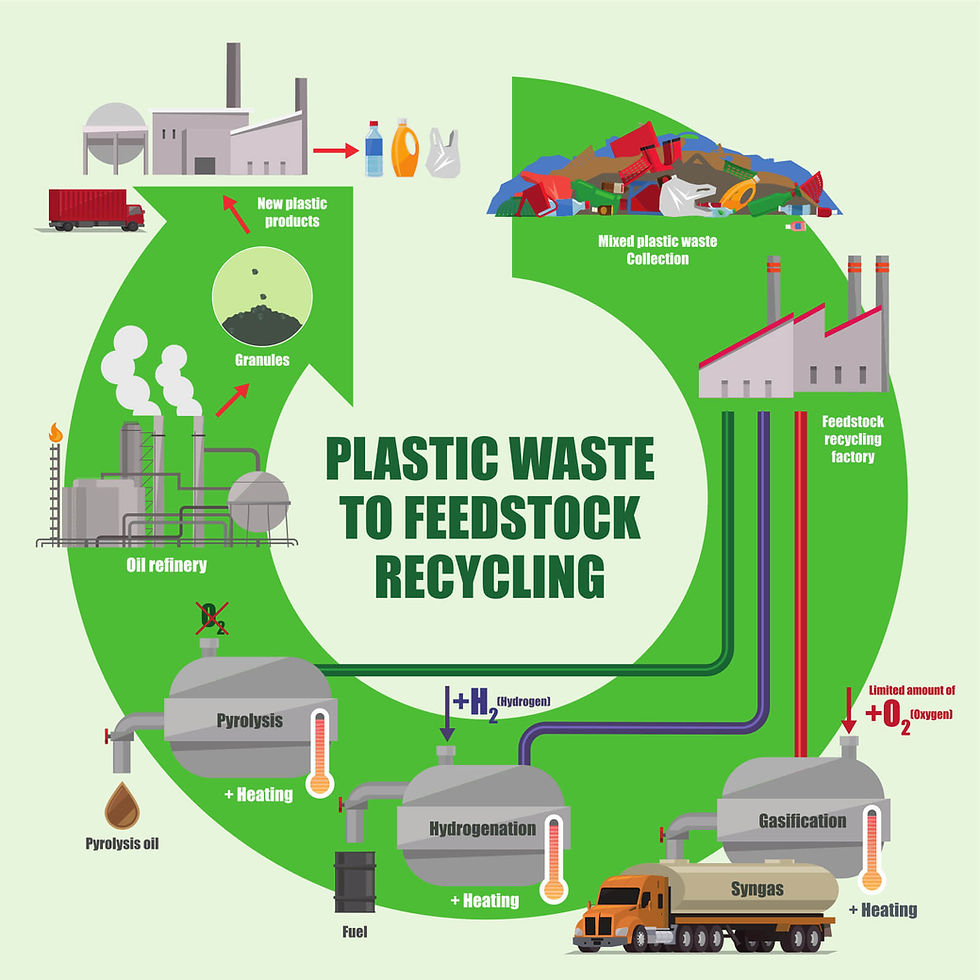How MaxFlux™ Outperforms Conventional Hydrotreating Technology
- cemnar0
- Jul 17
- 2 min read

Introduction
Plastic pyrolysis oils (PPO) are a promising route to close the loop on plastic waste, but their complex mix of contaminants makes purification a serious technical hurdle for refineries and petrochemical plants. Traditional trickle-bed hydrotreaters, long used in refining, struggle to efficiently upgrade these oils.
That’s where Sulzer’s MaxFlux hydrotreating technology steps in offering a new standard in efficiency, robustness, and product quality.
MaxFlux vs. Traditional Trickle-Bed Hydrotreaters
Common Challenges with Trickle-Bed Systems:
Hydrogen Diffusion Limitations: In conventional systems, hydrogen must move from the gas phase into the liquid, restricting reaction rates and reducing overall contaminant removal.
Thermal Management Issues: Managing exothermic reactions requires injecting quench hydrogen between catalyst beds, adding complexity and increasing utility costs.
Complex Gas Circulation: Recirculating large volumes of hydrogen gas demands additional compressors, piping, and costly energy input.
Flow Distribution Problems: Ensuring uniform feed and hydrogen mixing across the catalyst bed is difficult, potentially causing bypassing and incomplete upgrading.
The MaxFlux Advantage:
High Liquid Flux Operation: MaxFlux dissolves hydrogen fully into the liquid at the reactor inlet, erasing mass transfer limitations and maximizing intrinsic reaction rates throughout the catalyst bed.
Stable Thermal Control: The large liquid volume acts as a “thermal buffer,” absorbing exotherms, minimizing temperature spikes, and reducing the risk of over-cracking or unwanted byproducts.
No Gas Recycle Loop Required: With hydrogen fully dissolved up front, MaxFlux eliminates the need for gas recycle circuits, compressors, and associated controls cutting CAPEX and OPEX.
Optimized Reactor Internals: Custom mixing and distribution ensure every part of the catalyst bed is active, extending catalyst life and ensuring product consistency.
Measurable Performance Improvements
Sulzer MaxFlux consistently exceeds the performance of conventional hydrotreating for PPO purification:
Contaminant | Typical PPO Feed | Steam Cracker Spec | MaxFlux™ Product |
Nitrogen (ppmw) | 400–1,500 | <100 | <10 |
Sulfur (ppmw) | 30–200 | <500 | <50 |
Silicon (ppmw) | 35–50 | <1 | <1 |
Chlorine (ppmw) | 30–150 | <1 | <3 |
Olefins (wt%) | 45–55 | <1 | <2 |
Metals (ppmw) | 25–50 | <1 | <1 |
Longer Catalyst Life: Gentler process conditions reduce coking and deactivation, lowering maintenance costs.
Higher Yields, Less Overcracking: Stable temperature profiles mean more naphtha, less gas, and superior end-product yields.
Lower Utilities: By eliminating the gas recycle loop and requiring fewer compressors, MaxFlux shrinks energy bills and plant footprint.
Real-World Impact
Plants upgrading to MaxFlux report:
Immediate compliance with even the strictest downstream cracker specifications
Simpler operation, less downtime, and reduced need for corrective maintenance
Flexible adaptation to variable-quality plastic waste feeds
Conclusion
Sulzer’s MaxFlux hydrotreating technology isn’t just an upgrade from standard trickle-bed designs it’s a total re-imagining of how to process challenging plastic-derived oils.
For any operator seeking reliable contaminant removal, improved economics, and product flexibility, MaxFlux is the proven, future-ready solution.



